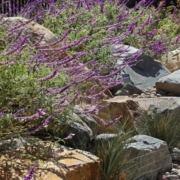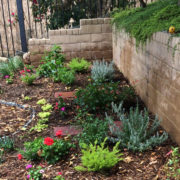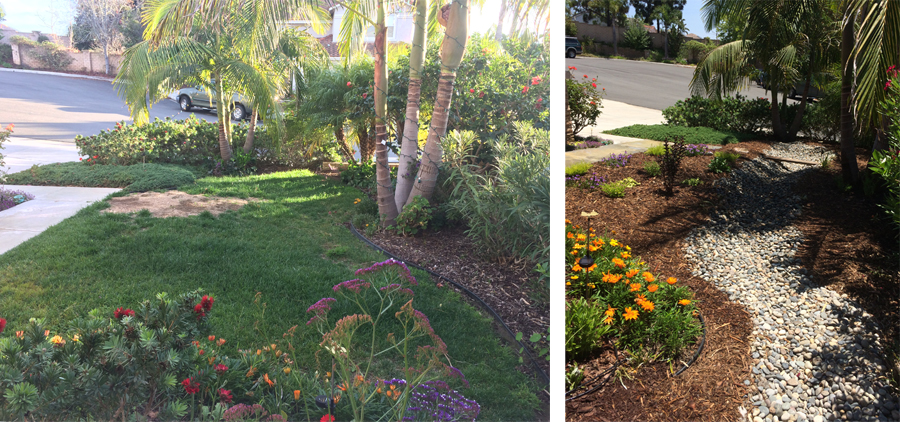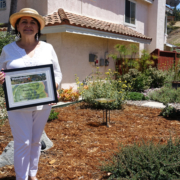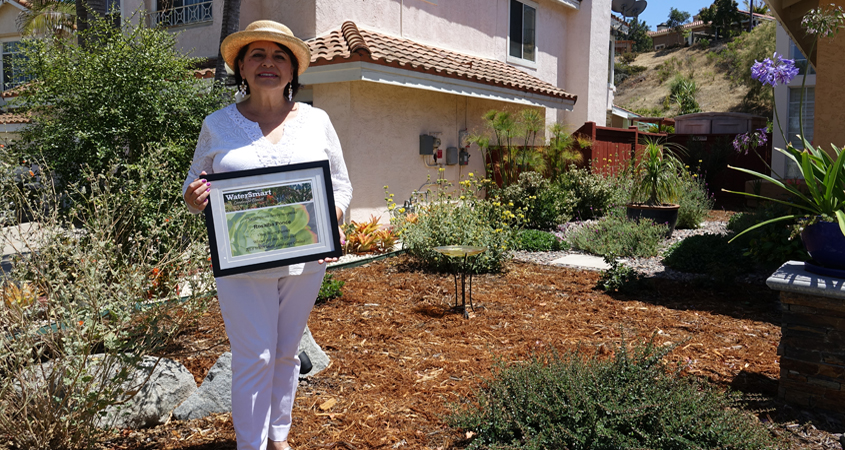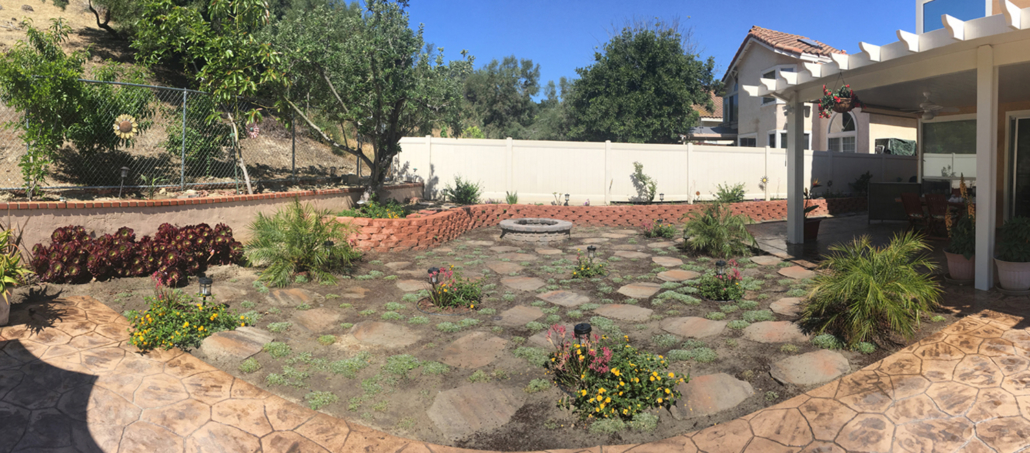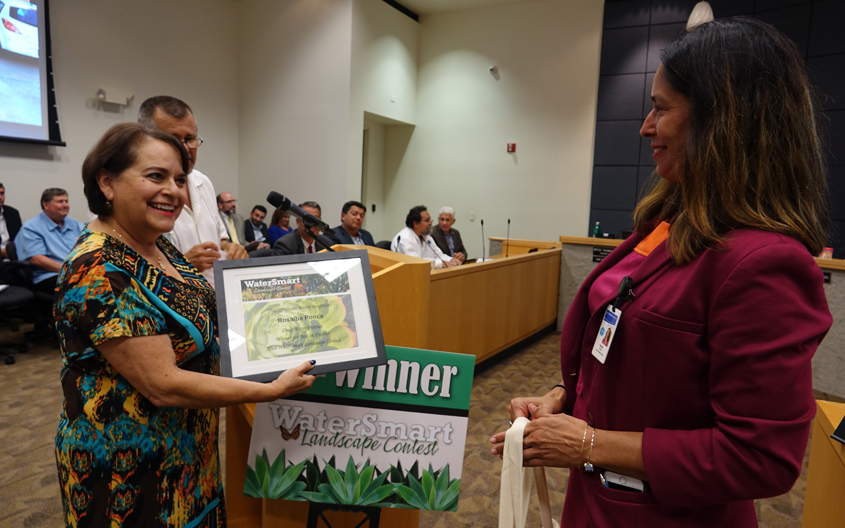San Diego’s Sustainable Landscapes Program ranked among the most effective landscape transformation programs in the nation in a study released today by the Chicago-based Alliance for Water Efficiency. The “Landscape Transformation Study: 2018 Analytics Report” compiled data from 14 similar landscape conservation programs in the U.S. and Canada.
The Alliance for Water Efficiency concluded that San Diego program participants reduced water use by an average of 114.8 gallons per day, or 34.8 percent. “The Water Authority has established a high benchmark for landscape transformation programs that include rigorous program requirements that result in the achievement of multiple benefits,” according to the report.
By saving about 42,000 gallons of water per project each year, Sustainable Landscapes Program participants who transformed their landscapes save enough water to supply the average four-person household in San Diego County for more than three months.
“This study highlights our success improving water-use efficiency across the San Diego region,” said Jim Madaffer, chair of the Water Authority’s Board of Directors. “We empower program participants to take a hands-on approach to WaterSmart living, and it’s gratifying to see their pride of ownership in these projects that are changing the way San Diegans think about landscapes. An enhanced environment and happy homeowners are part of the promise of sustainable landscaping.”
The national report was accompanied by a survey of more than 3,000 homeowners across North America, which emphasized that residents are ready to embrace new landscape ideals.
“Beautiful landscapes are a source of pride for homeowners, but the emotional connection we have with our outside spaces is not in conflict with a more sustainable approach. People also want to be smart water users,” said Mary Ann Dickinson, president and CEO of the Alliance for Water Efficiency, in a press release today. “Whether it’s installing a more efficient irrigation system, opting for drought-tolerant turf or re-landscaping with climate-appropriate plants, we need to communicate that a sustainable landscape can be beautiful and water-conscious.”
Empowering WaterSmart lifestyles
Efforts to develop the San Diego landscape program began in 2010 with a successful Proposition 84 grant application. Known as the SLP, the program was developed to help homeowners upgrade their yards with climate-appropriate plants, high-efficiency irrigation equipment, rainwater capture and detention features, and soil amendments. The sum of these measures results in multiple environmental benefits, including water use efficiency.
The SLP was a partnership by the San Diego County Water Authority, the City of San Diego, the County of San Diego, the Surfrider Foundation, the California American Water Co. and the Association of Compost Producers. Although the grant-funded SLP pilot has been completed, the Water Authority continues to offer and promote SLP-related programs and resources, such as classes and personalized advice from landscape design professionals, a comprehensive guidebook, financial incentives, a demonstration garden and SustainableLandscapesSD.org.
Water Authority Water Conservation Program Manager Carlos Michelon said the SLP sets high standards for efficient water use and other sustainable practices above and beyond standard turf removal programs. Participants achieve multiple benefits, including water efficiency, drought tolerance, stormwater management, water quality enhancement and aesthetically appealing designs.
“Using smart irrigation technology and climate-appropriate plants to increase water-use efficiency makes sense,” Michelon said. “Doing so while also tapping rain water as a resource, improving soil health, and creating other environmental benefits makes even more sense. That’s sustainable landscaping in a nutshell.”
Recognizing the variety of landscapes and microclimates in San Diego County, SLP resources helped to inform and empower participants each step of the way.
“When it comes to sustainable landscaping, planning and collaboration are as critical as soil amendments or detention basins, Michelon said. “The synergy resulting from our collaborative partnerships with other agencies and non-profit organizations has created even more value for participants and the region.”
Financial incentives help fund landscape projects
During a pilot period, the Water Authority and its partners provided more than 325 Sustainable Landscape Incentives to San Diego County homeowners to help transform their landscapes into beautiful, climate-appropriate mini-watersheds.
While this locally-administered program is no longer accepting applications, the Landscape Transformation Program administered by the Metropolitan Water District of Southern California is open to qualifying water customers in the Water Authority’s service area. Effective April 1, 2019, residential rebates will start at $2 per square foot, for up to $5,000 square feet. Added funding by local water agencies (where available) means total incentives may be as high as $3.25 per square foot. An online incentive calculator at SoCalWaterSmart.com identifies incentives for specific proposed projects.
The SLP was made possible by an Integrated Regional Water Management program grant funded by the Safe Drinking Water, Water Quality and Supply, Flood Control, River and Coastal Protection Bond Act of 2006, administered by the California Department of Water Resources.

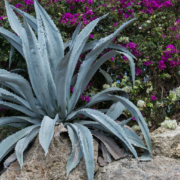
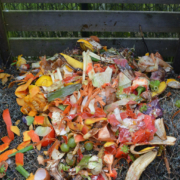 Compost can be beneficial in many ways, including functioning as mulch to prevent erosion and help soil filter pollution. Photo: Ben Kerckx/Pixabay
Compost can be beneficial in many ways, including functioning as mulch to prevent erosion and help soil filter pollution. Photo: Ben Kerckx/Pixabay